#696 Handbook of west coast nature
A Year on the Wild Side: A West Coast Naturalist’s Almanac
by Briony Penn
Victoria: TouchWood Editions, 2019 (second edition; first published by TouchWood, 1997)
$26.00 / 9781771512671
Reviewed by Luanne Armstrong
*
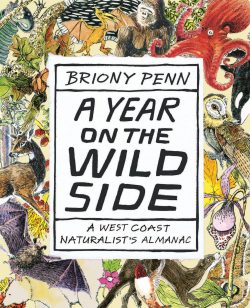 I love to walk and often when I do, I stop often and look under my feet, through the forest, into the water, up to the high peaks. I listen and wait. There is always much to see, hear, smell, touch. I am a high mountains and big lake kind of girl, but just the same, I am also a BC mountain girl, with extended periods of living in Vancouver and Victoria. For me, travelling to or living in a new ecosystem is always exciting. Everything is different; new smells, new colours, new sounds, new critters of all kinds. So I loved reading Briony Penn’s A Year on the Wild Side: A West Coast Naturalist’s Almanac, in part because it wasn’t my eco-system and so much was new to me. I learned so much. I read this book at night, chapter by chapter, and it was such a pleasure reading it that way because it felt like going for a beautiful and informative walk in places I had never been. And I could see them clearly because of the intricate paintings and drawings that accompany the text.
I love to walk and often when I do, I stop often and look under my feet, through the forest, into the water, up to the high peaks. I listen and wait. There is always much to see, hear, smell, touch. I am a high mountains and big lake kind of girl, but just the same, I am also a BC mountain girl, with extended periods of living in Vancouver and Victoria. For me, travelling to or living in a new ecosystem is always exciting. Everything is different; new smells, new colours, new sounds, new critters of all kinds. So I loved reading Briony Penn’s A Year on the Wild Side: A West Coast Naturalist’s Almanac, in part because it wasn’t my eco-system and so much was new to me. I learned so much. I read this book at night, chapter by chapter, and it was such a pleasure reading it that way because it felt like going for a beautiful and informative walk in places I had never been. And I could see them clearly because of the intricate paintings and drawings that accompany the text.
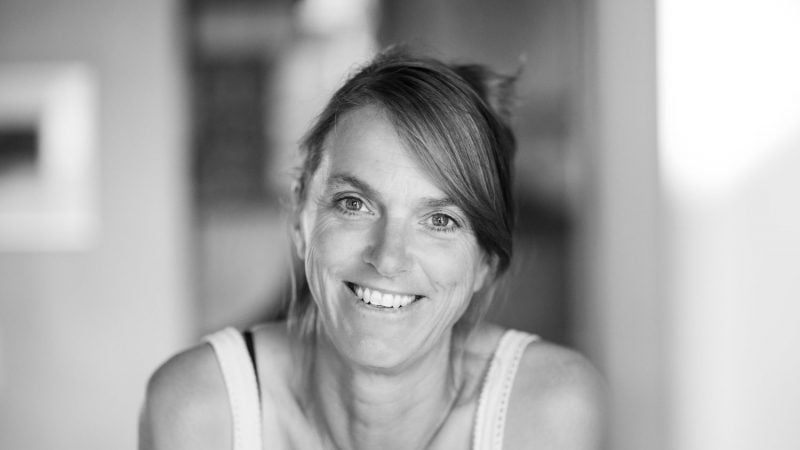
 Place-based knowledge and stories are incredibly important. It’s one thing to care abstractly about something, but if it is somewhere you know, somewhere you share with its non-human habitants, and that you experience everyday, then you know the true depth of loss when such a place is destroyed by endless mindless growth.
Place-based knowledge and stories are incredibly important. It’s one thing to care abstractly about something, but if it is somewhere you know, somewhere you share with its non-human habitants, and that you experience everyday, then you know the true depth of loss when such a place is destroyed by endless mindless growth.
A Year on the Wild Side is a wonderfully accessible and readable companion for people anywhere who live with a rooted sense of place, who walk, who look, and who want to know what is around them. The book’s chapters range all around the Salish Sea and around the seasons as well. Each piece is fairly short and punchy, since they were originally written as newspaper columns, so each one packs a pithy amount of information into two or three pages. The writing is well supported by the sepia-toned pen and ink drawings that accompany each subject. I consider myself fairly well read in terms of nature topics, but I gained a lot and learned a lot from this book.
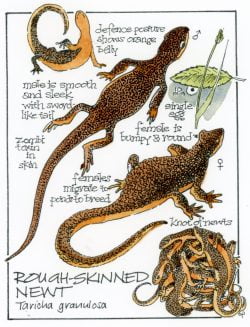 Penn is a prolific award-winning writer who has contributed much to nature writing from BC. She has written three previous books and has a new one arriving in the spring of 2020.
Penn is a prolific award-winning writer who has contributed much to nature writing from BC. She has written three previous books and has a new one arriving in the spring of 2020.
She has been a newspaper columnist for decades, writing about environmental issues and natural history in newspapers, magazines, and government publications. She’s also written environmental guides and educational handbooks for teachers in British Columbia, and good on her for doing so.
She’s also put herself on the line many times. Penn first came to vivid public attention by riding a white horse through the streets of Vancouver in 2001, to protest clear-cut logging on Salt Spring Island. Since then, she has matured into a thoughtful writer, concentrating on natural history subjects for both children and adults and has also stayed in touch with the frontlines of the constant environmental conflicts going on in BC.
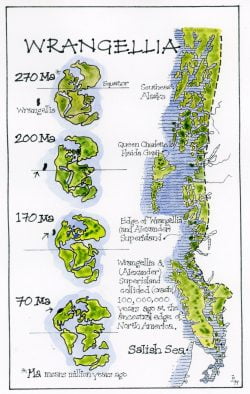 This book is a for-sure choice for a gift book. It can sit beside the bed, as it sits beside mine, to be dipped into with some satisfaction whenever someone has a question about, say, “What is Wrangellia?” (which I did not know). So, Penn presents 98 information-packed essays from areas all around Wrangellia. You could choose to read one essay a night, or one a week, or just power through the book, or dip into it depending on your interest and inclination. I find myself just thumbing through it, delighting in the drawings and the place-based writing. And perhaps I really did need to know more about the Roughhouse Newt or the Alligator Lizard, and where the whole ridiculous worship of “lawns” actually came from.
This book is a for-sure choice for a gift book. It can sit beside the bed, as it sits beside mine, to be dipped into with some satisfaction whenever someone has a question about, say, “What is Wrangellia?” (which I did not know). So, Penn presents 98 information-packed essays from areas all around Wrangellia. You could choose to read one essay a night, or one a week, or just power through the book, or dip into it depending on your interest and inclination. I find myself just thumbing through it, delighting in the drawings and the place-based writing. And perhaps I really did need to know more about the Roughhouse Newt or the Alligator Lizard, and where the whole ridiculous worship of “lawns” actually came from.
Briony Penn describes the book in her introduction as her “gumboot dance beside the glitter ball of the Salish Sea.” And a dance it is … chock full of humorous, witty, and dense observation about both the natural world and the social world of the west coast and islands of BC.
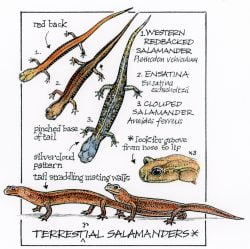 Penn is a close, wry observer of the world around her, and because the natural world and the human not-so-natural world are now intertwined, this also means writing about various people. For example, her delighted observation about the “sexiness” of herpetologists who, when they find a salamander, for example, “hold the delicate slippery animal briefly between cold confident fingers and run their index finger under its lip to feel for the male’s tiny teeth…. ” And, Penn adds, “I say thick mitts in a cold rink will never compete with those sensitive fingers in a lush and verdant rainforest.”
Penn is a close, wry observer of the world around her, and because the natural world and the human not-so-natural world are now intertwined, this also means writing about various people. For example, her delighted observation about the “sexiness” of herpetologists who, when they find a salamander, for example, “hold the delicate slippery animal briefly between cold confident fingers and run their index finger under its lip to feel for the male’s tiny teeth…. ” And, Penn adds, “I say thick mitts in a cold rink will never compete with those sensitive fingers in a lush and verdant rainforest.”
The book is full of similar observations, whether about walking through dense forest with antlers stuck to your head or the despair contingent on continuing to write about and advocate for the threatened non-human world. Penn’s writing style reflects its subjects: she presents dense, vivid image after vivid image, and her tone is thoughtful, careful, and caring. A Year on the Wild Side does indeed dance with the Salish Sea and all its multivaried inhabitants.
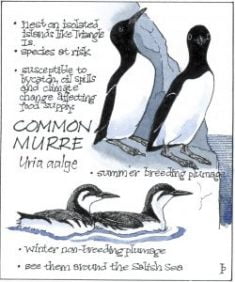 I am always to glad to find a book like this, the kind of book I seek out with delight and can re-read several times. I was also, incidentally, happy to share some anthology space with Penn in a book titled The Summer Book from Mother Tongue Press, also based on Salt Spring Island, published in 2017.
I am always to glad to find a book like this, the kind of book I seek out with delight and can re-read several times. I was also, incidentally, happy to share some anthology space with Penn in a book titled The Summer Book from Mother Tongue Press, also based on Salt Spring Island, published in 2017.
Penn’s new book, Stories From the Magic Canoe, written with Cecil Paul, an Xenaksiala elder, of stories in his ancestral home, the Kitlope — now the largest protected unlogged temperate rainforest left on the planet — appeared in Fall 2019 from Victoria’s Rocky Mountain Books, and Penn’s other book about Cecil Paul, Following the Good River, is due in May 2020.
I am very much looking forward to it.
*
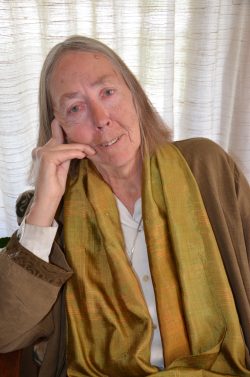
Luanne Armstrong has written 28 books. She writes young adult book, fiction, nonfiction, and poetry. She has contributed to many anthologies and edited a Canadian non-fiction anthology called Slice Me Some Truth (Wolsak and Wynn, 2011). She has been nominated or won many awards, including the Moonbeam Award the Chocolate Lily Award, the Hubert Evans nonfiction Book award; the Red Cedar Award, Surrey Schools Book of the Year Award, the Sheila Egoff Book Prize, and the Silver Birch Prize. Luanne lives on her hundred year-old family farm on Kootenay Lake. She mentors many emerging writers all over the world on a long term basis, and in the last three years has edited eight books through to publication. Her last book was Sand, a young adult book for Ronsdale Press. Her new book, A Bright and Steady Flame, The Story of an Enduring Friendship, was published by Caitlin Press in 2018. She is now working on a book of essays, Going to Ground, as well as a new book of poetry, When We Are Broken.
*
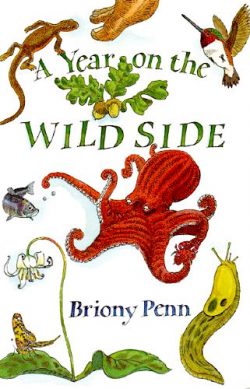
The Ormsby Review. More Books. More Reviews. More Often.
Publisher and Editor: Richard Mackie
The Ormsby Review is a journal service for serious coverage of B.C. books and authors, hosted by Simon Fraser University. The Advisory Board consists of Jean Barman, Robin Fisher, Cole Harris, Wade Davis, Hugh Johnston, Patricia Roy, David Stouck, and Graeme Wynn. Scholarly Patron: SFU Graduate Liberal Studies. Honorary Patron: Yosef Wosk. Provincial Government Patron since September 2018: Creative BC
“Only connect.” – E.M. Forster
2 comments on “#696 Handbook of west coast nature”